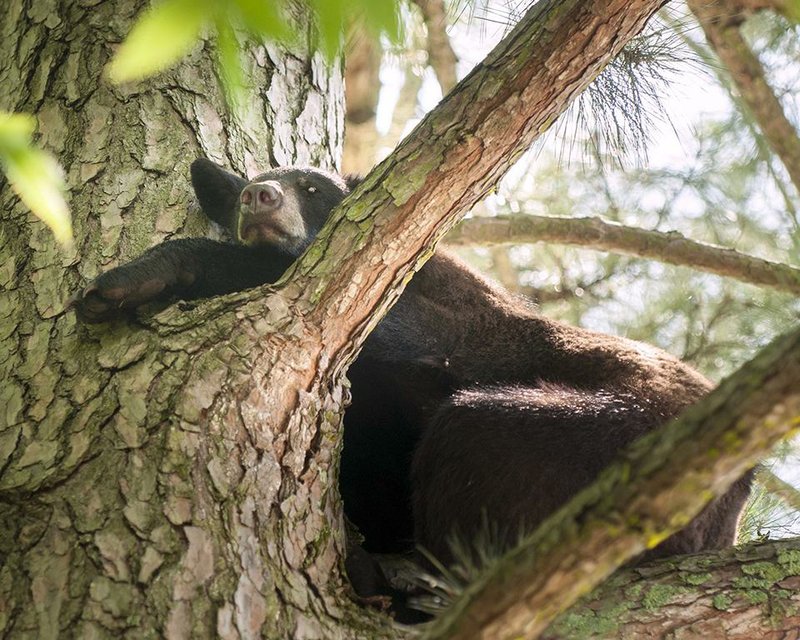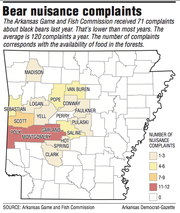Every spring, adolescent male black bears wander into Arkansas cities looking for food. They're the nomads of bear society, kicked out of their dens to make room for the next litters and looking for easy meals.
The Arkansas Game and Fish Commission gets about 120 legitimate bear nuisance complaints every year, said Myron Means, the commission's large-carnivore coordinator.
The peak was 314 in 2007. Last year, there were only 71 complaints.
The number of complaints corresponds directly with the availability of natural food in the forests. If a late frost kills the berry crop, as it did on Easter weekend in 2007, more young bears will look for food in towns, and the nuisance complaints will be high, Means said.
There was no late frost this year to exacerbate nuisance bear behavior.
The National Weather Service site for Fort Smith said the last frost this year was March 7. That's a month earlier than the 2007 frost, which was April 8.
Black bears are omnivores that eat primarily plants. But Means said black bears are "opportunistic feeders." In towns and suburbs, that means they'll get into garbage cans, dog food and bird feeders, he said.
"If you've got bear problems, 99.9 percent of the time it's food-related," he said. "If the food's gone, the bear leaves. I mean, they're walking stomachs."
There were two recent bear sightings in Harrison.
On Tuesday, a 100-pound black bear walked into Dardanelle, got frightened, climbed a tree at Second and Vine streets and was stuck there for most of the afternoon, said Police Chief Montie Sims.
Hundreds of people stopped by to take a look at it.
"We had the biggest mass of sightseers and drive-byers you've ever seen," Sims said. "A couple of hundred at least. There were that many people driving by trying to take pictures of the bear while it was up the tree."
Police closed streets for six hours to give the bear time to calm down and climb down. When it left the tree about 7 p.m., it ran two blocks, encountered people and went up another tree, where it remained until sometime during the night.
Means described it as a "big fiasco."
"I realize people want to see a bear in town, but when crowd control is basically left unchecked, it really hampers our ability to effectively deal with the bear and get the bear out of town," he said.
Means said the young black bears get into cities and don't know how to get out.
"They're just lost, and they're scared to death of people and dogs," he said.
Means said black bears aren't normally a threat to people.
"Non-habituated black bears typically are not a public safely threat in the respect of them running up and attacking someone unprovoked," he said.
"They are big, strong wild animals. If they have been habituated or are provoked for some reason, they can cause bodily injury or death. ... They aren't going to be running around town mauling people just because people are there. Left to their own, bears will usually find their way back out of town without any problems."
Black bears killed 63 people in North America from 1900 to 2009, according to a study by Stephen Herrero in the Journal of Wildlife Management. Eighty-six percent of those attacks occurred since 1960.
While deaths from black bear attacks are still rare, maulings or other aggressive behavior are becoming more common, according to an article last year in National Geographic. There were 92 black bear attacks across Canada and the United States from 2010-13.
Part of the problem is an increase in the number of people and bears, and more people are moving into bear territory. Young male bears killed the most people, according to Herrero's study. Male bears were involved in 92 percent of predatory attacks, and most of those attacks occurred in the wild.
American black bears are the smallest of the three bear species found in North America, and they are found only in North America. Black bears are the only kind of bears in Arkansas.
Black bears eat plants, fruits, nuts, insects, honey, salmon, small mammals and carrion. Occasionally, they will kill young deer.
Black bears measure 4-7 feet from nose to tail, and 2-3 feet tall at the withers, according to the North American Bear Center. Black bears have short claws that give them excellent tree-climbing ability.
The American black bear, Ursus americanus, is a genus and species. That doesn't mean they're all black in color. In Arkansas, about 25 percent of black bears have some color variation, such as brown, chocolate, cinnamon or a white chest blaze, Means said.
There are an estimated 750,000 black bears in North America and 300,000 in the United States. About 5,000 of them live in Arkansas, Means said. That would rank Arkansas about 22nd nationally in the number of black bears, based on numbers provided by the Black Bear Society.
Until 1923, Arkansas was known unofficially as "the bear state."
With thousands of Arkansas bears being killed every year, the state's bear population was very low by 1927, when bear season was closed. By the late 1940s, there were about 50 bears left in Arkansas, according to a study by the Arkansas Game and Fish Commission.
Between 1959 and 1968, 254 black bears were trapped in northern Minnesota and Manitoba, Canada, and released in Northwest Arkansas, where their population increased rapidly, according to the study.
Bear hunting in Arkansas resumed in 1980, but it was on a small scale until recently. In 1990, 19 black bears were killed in Arkansas. Last year, the number was 353. That's down from a record 530 in 2010.
Madison, Franklin, Polk and Scott counties usually lead the state in number of bears hunted and killed.
The largest black bears in Arkansas weigh more than 600 pounds, Means said. But that's considerably larger than the adolescent bears that typically venture into towns in and around the Ozark and Ouachita national forests of Arkansas.
When male bears reach 1.5 years of age -- between 50 and 120 pounds -- they're forced from the den, Means said.
"It's kind of like kicking a 13-year-old boy out into the street," he said. "They typically get into trouble. They're typically the ones who get into town this time of year. They're like little nomads. They don't have an established territory. They're sort of a homeless population."
The breeding territory of an adult black bear is usually 8-15 miles, but it can range over 125 miles, according to the North American Bear Center. Yearlings usually have a range of just 1-2 miles.
After roaming the margins of bear territory for a couple of years, the displaced yearlings grow to be large enough to challenge older bears and establish their own territory in the forest.
But in the meantime, they can be a nuisance to people who live in town. The bears, which are normally awake during the day, can become nighttime raiders on the outskirts of towns.
When Means gets nuisance bear complaints, he usually tells people to remove the food source. If that doesn't fix the problem, and if the bear damages property, it can be captured and relocated.
"If we catch a nuisance bear three times, the bear is euthanized," Means said. "However, if a bear shows signs of severe habituation to people or is unusually bold toward people, we euthanize the bear on a first offense."
Means said Fayetteville usually tops the list with the most bear nuisance calls in Arkansas, followed by Harrison. But bears are also seen in suburban Little Rock in the Ferndale area, he said.
Harrison Police Chief Paul Woodruff said he doesn't recall any bear sightings in town last year, but in 2007 a young bear got into town and had to be killed.
Since then, the city's animal control officers have acquired tranquilizers appropriate for knocking a bear out so it can be relocated.
Sgt. Craig Stout with the Fayetteville Police Department said he has no way of compiling figures on bear sightings.
If people encounter bears in Arkansas cities and towns, Means' main advice is to remain calm and leave them alone.
"The best thing to do is just kind of give the bear some space," he said. "If given the opportunity, they will leave town."
Means said people who have complaints about bears can call the Game and Fish Commission or their local law enforcement agencies.
Metro on 06/08/2015


